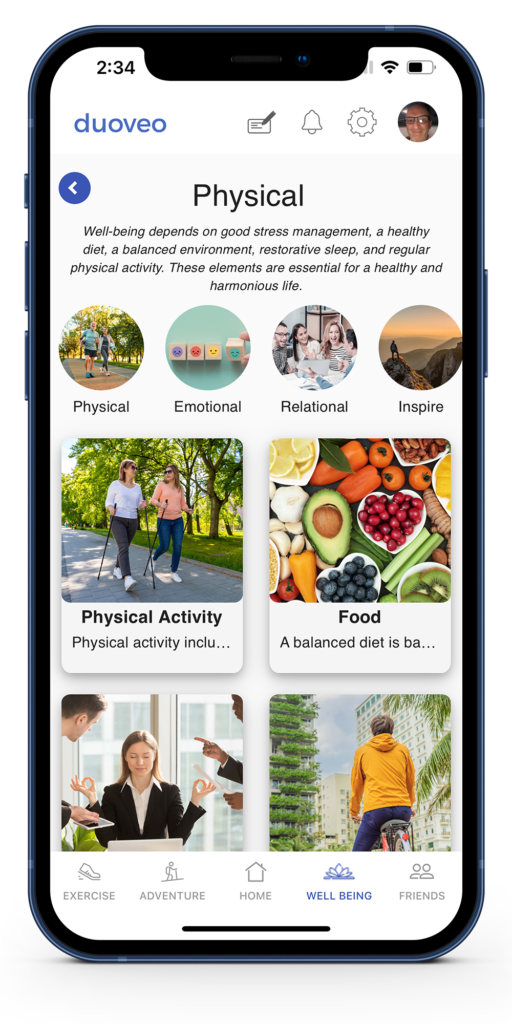Among the main causes of sleep disorders, mental ruminations, anxiety, and increased sensitivity to stress are regularly put forward. Natural techniques from different therapies can address these psychological factors, help comfort, and prevent sleep disorders and sleepless nights.
Sophrology & Sleep
The neuropsychiatrist Alfonso Caycedo created sophrology in 1960. This method aims to consider the individual as a whole. So that they become aware of their body in its entirety through the balance between thoughts, emotions, and physical sensations. It is an exclusively verbal and non-tactile practice. Moreover, this sleeping technique allows the “sophronized” person to better apprehend everyday life’s unexpected and difficulties. It combines 3 axes of exercises which act via :
- controlled breathing
- muscular relaxation by a dynamic relaxation
- visualization
This technique helps regain a state of well-being and to activate one’s full potential. Through these principles, sophrology is very suitable for relieving sleep disorders. By listening to the body, bodily sensations replace incessant thoughts. Furthermore, excessive expectations give way to letting go and allowing the body and mind to calm down. A study in the year 2000 revealed the effectiveness of sophrology with individuals who have chronic insomnia related to stress by modifying the negative perception of this disorder.
Meditative practices
All meditative practices allow us to modify the brain’s structure and release substances that make us more serene in our minds and body.
Mindfulness Mediation to prevent sleepless nights
Mindfulness meditation is about being and feeling fully in the present moment. This can be through guided meditations, visualizations, music, white noise, birdsong, a cat’s purr, or a fireplace’s crackle. These interludes can be ritualized on a daily basis. They are the key to relieving mental overload, intellectual fatigue, and anxiety which are responsible for many disorders and pathologies, such as sleepless nights.
Thus, mental rest is certainly the most powerful tool for regeneration today. It is associated with sensory rest (linked to bright lights, telephone or computer screens, ambient noise, etc.). The idea is to put your brain on pause.
Mindfulness meditation, allows the brain to switch to Alpha waves (8 to 13 hertz) or Theta (4 to 8 hertz). You can do it comfortably installed, in the quiet or to the sound of music or guided meditation, in the dark or with a mask over the eyes to limit stimuli.
- Alpha waves correspond to light meditation, the feeling of well-being, and the state of wakefulness.
- Theta waves occur during relaxation or deep meditation in full wakefulness or during hypnosis sessions. It is a moment suspended between wakefulness and sleep. It is precisely this moment that is sought after when falling asleep.
You can also achieve mental rest by writing if you tend to ruminate before or at bedtime. Indeed, by writing down in a notebook near the bed the constant thoughts, you can free them.
Sound therapy

Sound Therapy, like mindfulness meditation, is also part of meditative practices. Indeed, sound vibrations used therapeutically help to calm the body and mind. These sounds come mainly from gongs, therapeutic tuning forks, Tibetan bowls, or the voice.
Our organs and cells vibrate, and our body emits an electromagnetic field. These vibrations vary according to our state of health and our mood. Water, representing about 60 to 70% of our body weight, is a conductive element.
Thus, the frequencies emitted by the instruments and our body’s frequencies enter resonance to reharmonize each other. If we use the voice, the vibrations directly emitted by the body act from within. One can imagine the repetition of a chanted mantra and the sound “Om” to enter a state of relaxation. Through these vibrations, the brain is immersed in a meditative bath with obvious benefits, especially on stress.
You can also listen to the healing sounds of Dr. Jeffrey Thompson, considered the greatest researcher in sound healing and an expert in brainwave training. Sound Therapy will help you improve your sleep and avoid sleepless nights.
Avoid sleepless nights with breathing
Breathing is physiological and vital, but we breath in an anarchic way over time. Indeed, it is due to our often too stressful daily life. A short, rapid, superficial breath, as if “blocked”, no longer meets the body’s needs and contributes to restless, non-restorative sleep and sometimes sleepless nights.
Correct breathing oxygenates our cells better and allows a better elimination of acid waste. Moreover, it considerably reduces the production of noradrenalin (a hormone associated with stress). Finally, it participates in the proper functioning of the digestive system, all of which contribute to a more peaceful night.
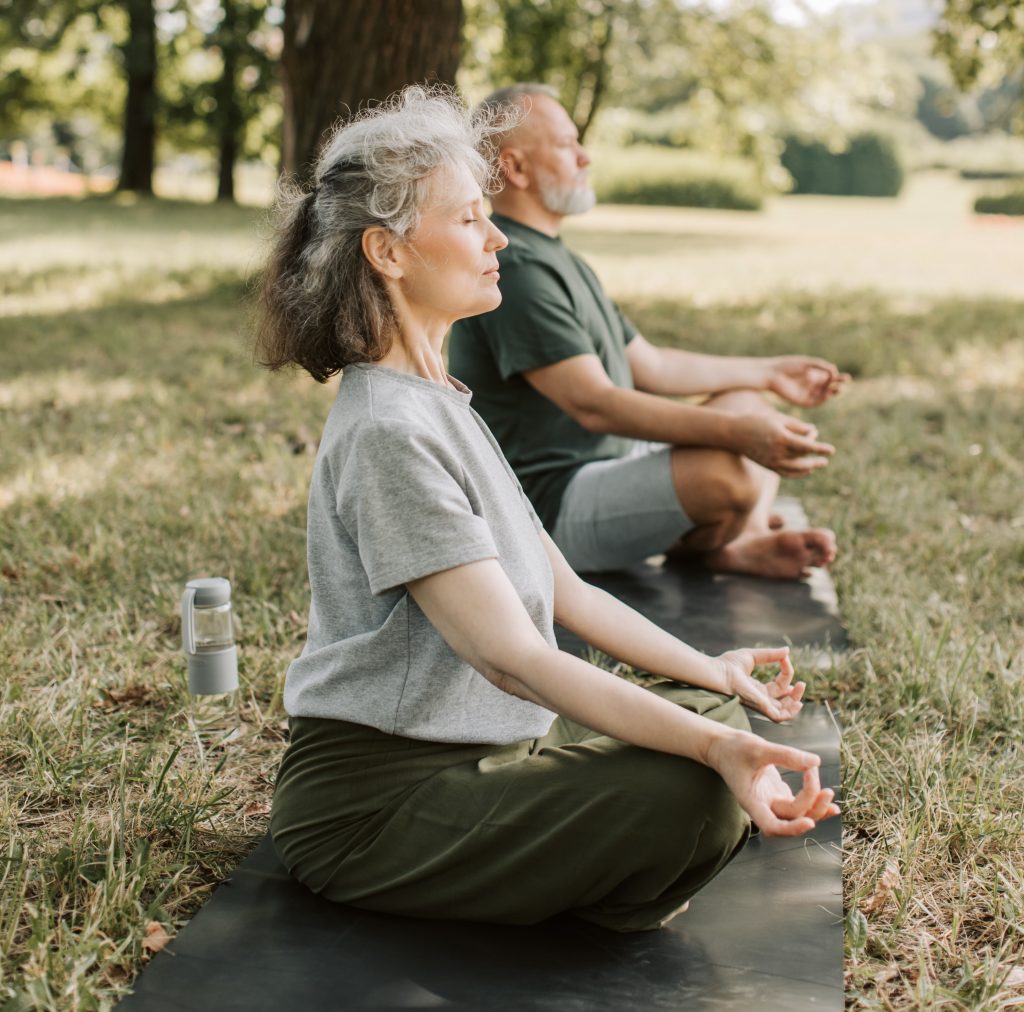
Good breathing also stimulates the production of GABA, which is an essential neurotransmitter in sleep quality. Therefore, this neurotransmitter has a calming effect on the central nervous system and the activity of neurons. In addition, Mindfulness meditations or yoga (see later in the article) also stimulate GABA during their practice.
Types of breathing
Several types of breathing are possible. It is important to choose the one that suits you and soothes you. Indeed, it will help you feel its immediate benefits. Unless there is a particularity in the exercise or physiological impossibility, it is essential to always breathe through the nose. This is because the air that enters through the nostrils is filtered and humidified to bring the optimal quality of oxygen to our cells. Among the great classics:

- Cardiac Coherence that is 5-5-5 one inhales on 5 beats, one exhales on 5 beats, for 5 min. For more information: Cardiac Coherence
- Alternate breathing: on 4 beats each time, we block the left nostril by breathing in through the right and then block the right nostril by breathing out through the left. Then, we breathe in through the left nostril, then we close again to exhale through the right nostril.
- The Abdominal Breathing, long and deep, one hand on the belly, sitting or lying down to feel the belly inflating and deflating. This type of breathing is much more beneficial than the shallow chest breathing we stay in too long.
- But the leading breathing for falling asleep is the 4-7-8 method.
Dr. Andrew Weil of Harvard University developed this method. The precepts of sophrology and the breathing exercises of yoga inspired him. This technique brings a more important oxygen flow than during normal breathing. Thus, it stimulate the parasympathetic nervous system. The latter, over-solicited during periods of stress, allows you to quickly reach a state of physiological relaxation, which is favorable to sleep.
How to practice the 4-7-8 method?
- You sit comfortably in a lying position,
- Place the tip of the tongue against the palate, just behind the incisors. It is important to maintain this position throughout the practice!
- One drives out completely the air of the lungs until they are emptied,
- Inhale slowly and deeply through the nose, counting to 4,
- Hold your breath for a count of 7,
- We exhale powerfully through the mouth (always with the tongue on the palate), counting to 8,
- You can repeat this breathing 3 times or until you fall asleep.
Yoga to prevent sleepless nights
Practicing yoga daily, even for a few minutes, at the end of the day or in the evening, helps to dissipate the physical and psychological tensions accumulated during the day. It is a source of calm, allowing mental relaxation, emotional release, and muscular and articular relaxation. Indeed, under stress, the body can be put “under tension,” and yoga facilitates the release of blockages. Particularly at the solar plexus (diaphragm) level, the back, and the digestive system. Among the different yogas, Nidra, or “sleep yoga” (nidra means sleep in Sanskrit), is specially adapted in case of anxiety, anguish, negative stress, or emotional disorders.
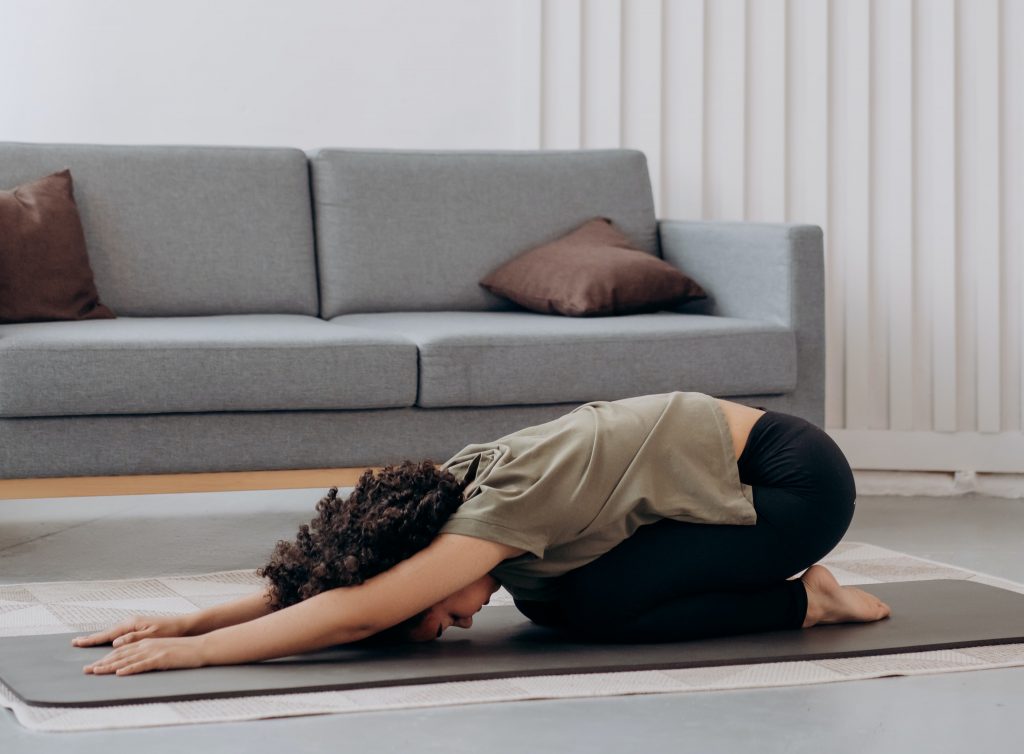
During the practice, the aim is to reach a state of deep relaxation between falling asleep and awakening consciousness in order to release all tension in the body and mind. Thus, saving you from sleep disorders such as sleepless nights.
This yoga is accessible to all and requires no physical requirements. Here you can find some examples of postures that promote deep and restful sleep (Note that golden rule is to never going into pain) :
The child's posture - BALA SANA:
In a kneeling position, sitting on the heels, we spread the knees so that they are in line with the hips. We inhale and exhale slowly while bending slowly forward until we put the forehead on the ground and the chest on the knees. To bring back then the arms above our head by stretching them then again along the body towards the feet, palms towards the sky. We keep the posture for a few minutes without forgetting to breathe.
Mountain posture - TADÂSANA :
The two feet parallel to the ground, we start by finding the best possible stability. Then, we stretch our spine to grow as much as possible until the top of our head. After, we join our hands in front of our chest in prayer, then on a deep inhale through the nose, we raise our arms towards the sky, always keeping our hands joined. We hold our breath for a few seconds then we release on the expiration. We repeat the movement about ten times, then a second time, we start the same exercise again by taking off the heels on tiptoe to stretch better still and to grow a little more. Repeat this movement about ten times also.
Legs up on the wall - VIPARITA KARANI:
Particularly suitable for people who stand for long periods of time during the day. It consists in lying comfortably on the back (on the bed or on the ground) by making sure that the neck is supported and the lumbar vertebrae are well put on the ground. Then we raise our legs by sticking the buttocks well against the wall so as to form a right angle. Then we extend our arms on each side of the body by stretching them to touch the side walls. We associate with this position a slow breathing exercise like an inspiration in 4 times and an expiration in 6 times on about ten cycles. At the end of the exercise, we resume normal breathing, fold our legs, and we turn gently on the side by helping ourselves with our arms to get up slowly.
Ergonomics & Sleep
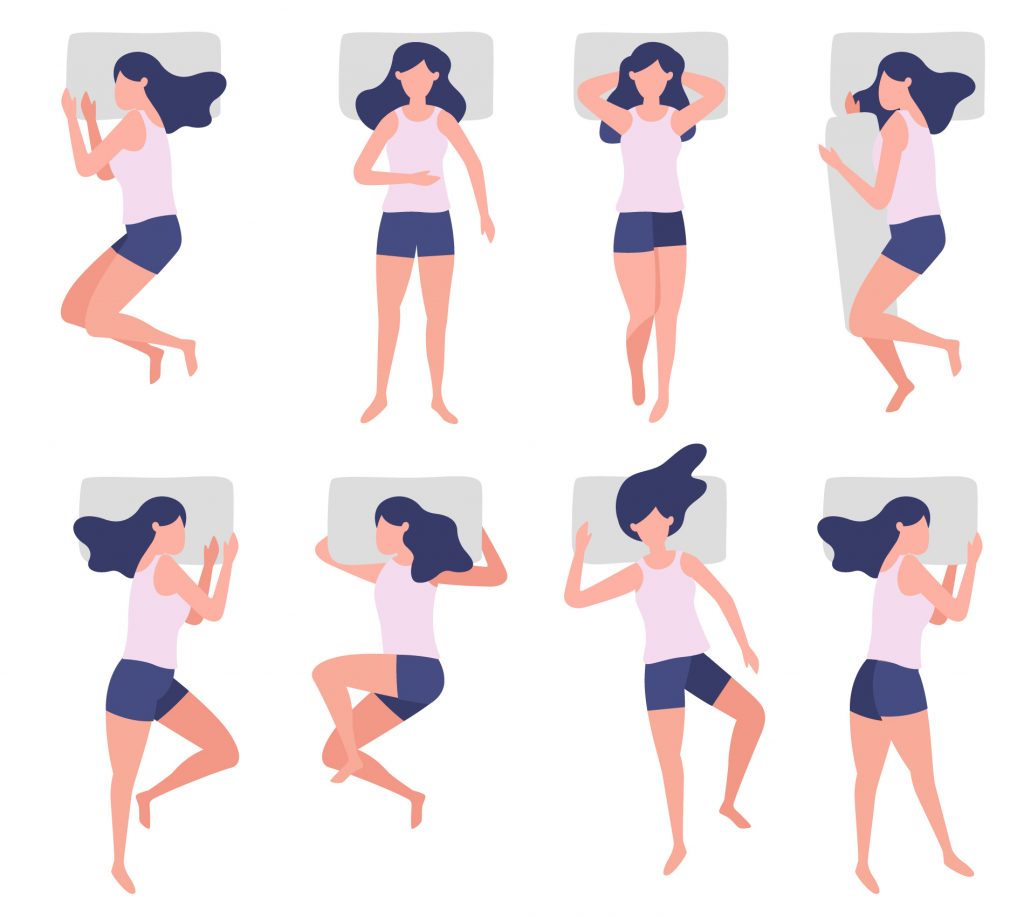
Some pre-lying postures help people fall asleep, but the position in the bed also plays a major role in optimal healing sleep. It is called sleep ergonomics, and it determines the best position for the body in bed. But also the most suitable bedding equipment for a pain-free night’s sleep, as regenerative as possible.
Three possible positions to start the night and avoid sleepless nights:
- The stomach: this position accentuates the lumbar arch and creates significant tension by rotating the neck at the cervical and upper back levels. It can also increase the risk of numbness in the extremities. It is preferable not to favor this position. However, if you have been in this position for several years, you can opt for a support cushion for the lower abdomen. It is also important not to neglect stretching and to work on the mobility of the neck joints in order to limit stiffness in the cervical area.
- The back: this position with the legs totally extended is slightly spread (not crossed, which increases the tensions at the level of the small pelvis). This limits the tensions in the spinal column. However, be careful because it can be conducive to snoring or sleep apnea. When a lumbar arch causes discomfort when lying on your back, you can place a cushion under your knees to relieve the tension. When sleeping on the back, the pillow should have a slight indentation in the center so that the back of the head can be positioned there.
- The side: the position on the side, in “fetus”, is the most adapted to limit chronic back pain. The head should be aligned with the spine, and the thickness of the pillow should be the same as the height of the shoulder. In general, and especially for pregnant women, it is preferable to sleep on the left side to avoid compressing the vena cava.
Hypnosis
Hypnosis is an ancient therapeutic practice carried out by a therapist via the spoken word. It consists of bringing the individual into a particular state of consciousness, a kind of dream, between wakefulness and sleep.
This state of hypnotic consciousness is characterized by external indifference and hyper-suggestibility, allowing one to act on stress, anxiety, or pain. Therefore, it is an interesting method to relieve physical tensions or to interrupt incessant ruminations, which are often conducive to sleepless nights and not restful sleep. Hypnosis also leads us to have confidence in our ability to sleep. This is done by searching our unconscious for what may be a barrier to sleep.
In the process of autonomy, self-hypnosis allows you to use hypnosis alone without being guided by someone. However, regular practice is necessary to have satisfactory results.
Light Therapy
Exposure to natural light during the day is essential. It is also preferable to use soft indirect light before bedtime, such as lamps, especially in the bedroom. If despite respecting these basic rules, there is a prolonged disruption of the circadian cycle, light Therapy can give positive results.
Also called heliotherapy, it consists of exposing the face or part of the body to a source of artificial white light that imitates natural sunlight.
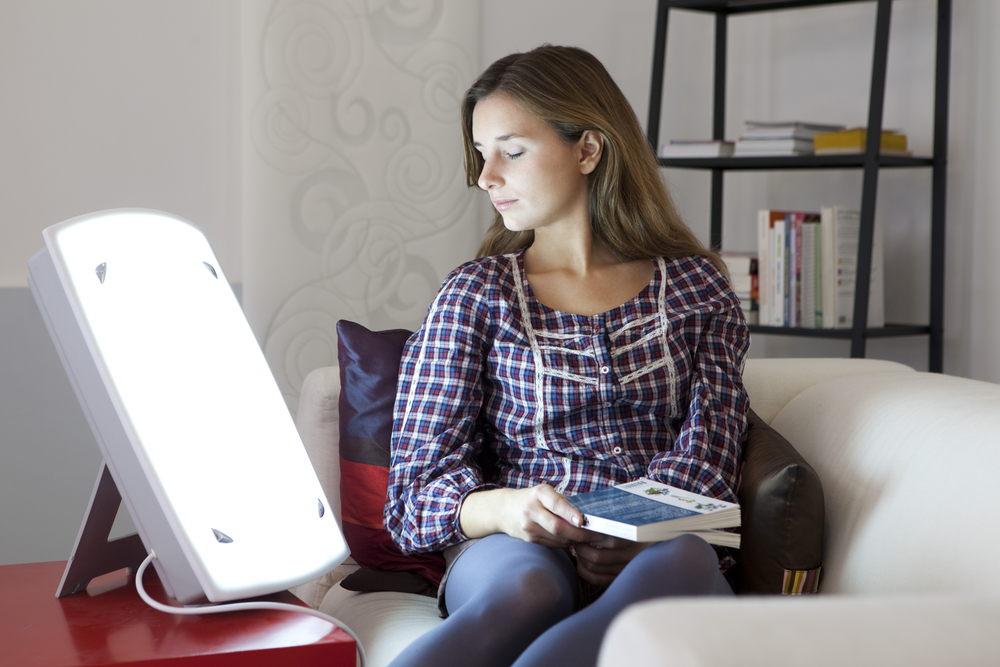
It also allows the body to “readjust” the synthesis of hormones and to secrete melatonin, dopamine and serotonin at the right time of the day. This makes it easier to fall asleep, promotes restful sleep and prevents sleepless nights. We can add to these techniques the Feidenkrais method, massages, acupuncture or Qi Gong.
Bottom line
Among of all these techniques, no matter which ones resonate with you, the key is to tend towards a letting go, a relaxation of the mind by ceasing to think about the past day or the next day’s parasitic ideas, by “distracting” the mind. This kind of bedtime ritual will focus your thoughts on the positive and will naturally lead to a softer, more restful night, saving you from sleepless nights.
If you want to learn more about sleep, don’t hesitate to have a look on my dedicated website: Jeûne & Sens
Would you like to discover more information about sleep?
Have a look at our other articles :


